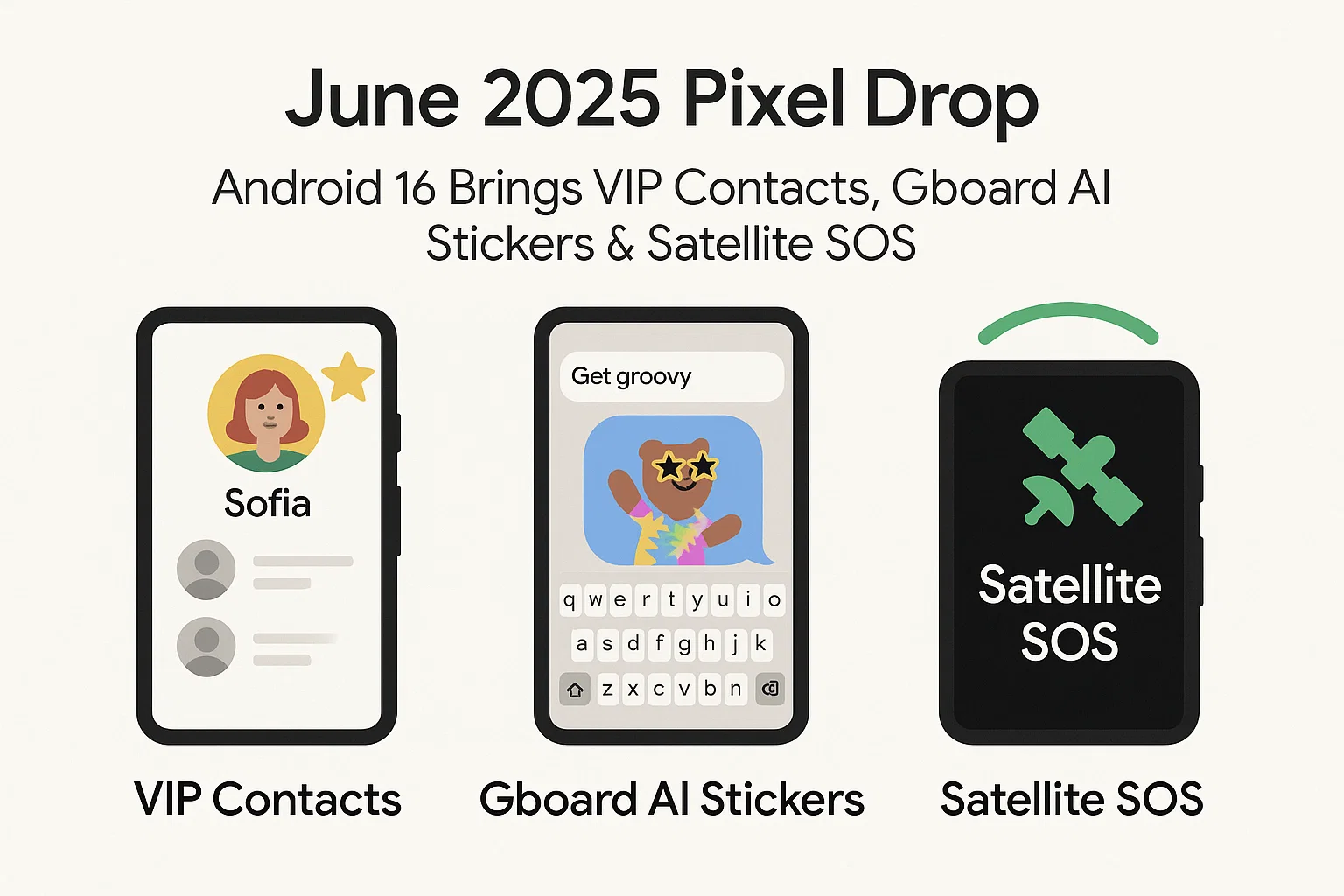
Android Revolution Begins: June 2025 Pixel Drop Introduces VIP Mode, AI Stickers & Emergency Satellite SOS
June 10, 2025 marked a major milestone in the Android world. Google officially rolled out Android 16 (internal codename Baklava) to Pixel devices—and alongside it came the June Pixel Drop, a feature-packed update designed exclusively for Pixel users. While Android 16 brought sweeping system-wide improvements—like Material 3 Expressive design, Live Updates, Gemini AI integration, enhanced security, and power-user features—the June Pixel Drop adds the final flourish with Pixel‑exclusive tools that make daily life more personal, creative, and secure finance.yahoo.com+13wired.com+13chromeunboxed.com+13wired.com+3en.wikipedia.org+3wired.com+3. In this in-depth blog, we’ll explore three standout features: We’ll also highlight other important enhancements—accessibility, Camera tips, battery care, and AI-powered magic in Recorder, Photos, and accessibility. Let’s dive in. 1. Pixel VIPs: Make Your Closest Contacts a Part of Your Phone What Are Pixel VIPs? Pixel VIPs is a dedicated widget within the Contacts app for Pixel 6 and newer devices running Android 16. Instead of just displaying contacts, this widget creates a dynamic, live-updating “VIP panel” for your most important people reddit.com+6blog.google+69to5google.com+6chromeunboxed.comen.wikipedia.org+1blog.google+1indiatimes.com. Core Features Why It Matters In our fast-paced lives, our phones juggle hundreds of contacts. VIPs bring clarity—showing the people who matter most, right front and center. Whether it’s coordinating with a spouse, tracking a family member, or staying in close touch with a buddy, it helps you stay connected in context. A widget someone dubs “consolidated communication HQ”—seeing last messages, calls, notes, birthdays—without launching apps.— r/Android users on Pixel VIPs indiatimes.com+5reddit.com+5theverge.com+5 That feedback underscores how Pixel VIPs turns scattered info into meaningful connection. 2. Gboard AI Stickers: From Text to Visual Magic The Power of Pixel Studio Integration Gboard, Pixel’s default keyboard, now includes deep integration with Pixel Studio’s generative AI. That means crafting stickers isn’t limited to external apps—you can create them right from the keyboard interface finance.yahoo.com+8blog.google+8chromeunboxed.com+8. What You Can Do Why It’s a Creative Leap Sticker culture exploded with Emoji Kitchen, but this feature goes further: AI-assisted graphics that are entirely personal. Want to send a sticker of your real-life pet wearing sunglasses? Now you can—with zero graphic design skills required. 3. Satellite SOS: Emergency Reach—Even Off the Grid New Availability in Australia With Pixel 9 lineup featuring the Tensor G4 chip and Skylo satellite tech, Satellite SOS launches in the U.S., Canada, UK, Europe—and, as of June 2025, now Australia chromeunboxed.com+5blog.google+5en.wikipedia.org+5. How It Works Without cell or Wi‑Fi, Pixel 9 series users can: Google offers it free for two years post-activation, subject to availability chromeunboxed.com+5blog.google+5indiatimes.com+5droid-life.com. Real-World Impact Whether you’re hiking Australia’s outback or caught in a blackout, Satellite SOS ensures help is just a button away. This reflects Google’s vision of safety-first innovation—even when solar signals power your safety, not towers. 4. Android 16 Core Enhancements: A Broader Context The June feature drop enhances Pixel’s toolkit—but these features build on Android 16’s broader foundation. Here’s a quick look: 5. Other Pixel Drop Enhancements Worth Mentioning Beyond our Big Three, the June Pixel Drop raises the standard on Pixel devices: Battery Health Monitor Available on Pixel 8a+ and Pixel 9 series, this tracks battery capacity and lifespan—suggesting timely battery replacements reddit.com+3droid-life.com+3blog.google+39to5google.com+1droid-life.com+1. Camera Education Hub Tap the “?” icon in Camera app to access visual examples, mode explanations, and composition tips—great for photography enthusiasts blog.google+39to5google.com+3chromeunboxed.com+3. Real-Time Live Search in Magnifier No need to snap a pic—scan menus or surfaces live, highlight matches, and get haptic feedback when found chromeunboxed.com. Recorder Enhancements Expressive Captions Now supports elongated words (“yessss!”) and expands its geographic reach to Canada, UK, and Australia 9to5google.com+2blog.google+2chromeunboxed.com+2. Google Photos AI Editing One-tap “AI Enhance”, scenario-based tools, smart cropping, and reimagining features—soon synchronized across all Android devices droid-life.com+1en.wikipedia.org+1. 6. What This Means for You Personal Connection VIPs keep your most important relationships front and center—with context, ease, and respect for privacy. Creative Communication Building expressive, custom stickers fosters fun, individuality, and emotional nuance in digital chats. Safety Matters Emergency connectivity through Satellite SOS now covers a wider geographic footprint. Inclusivity & Usability Live search, Expressive Captions, Clear Voice—and hearing aid support—demonstrate Google’s push for global access. Empowered Imagery Camera guides plus AI editing tools offer both beginners and pros deeper creative options. 7. But… What About Your Device? Here’s who gets what, when: Feature Supported Devices Pixel VIPs Pixel 6+ (with Android 16) AI Stickers Pixel 9 series Satellite SOS Pixel 9 series (U.S., Canada, UK, Europe, Australia) Battery Health Pixel 8a+, Pixel 9 series Magnifier Live Search Pixel 5+ Recorder AI Summaries Pixel 6+ (French, German) Clear Voice Recorder Pixel 8+ Note: As one Redditor complained, “No AI sticker creation in Gboard yet on my Pixel 8 Pro”—it’s still exclusive to Pixel 9+ blog.google+5chromeunboxed.com+59to5google.com+5support.google.comchromeunboxed.com+5blog.google+59to5google.com+5support.google.com+12reddit.com+12blog.google+12indiatimes.com+159to5google.com+15wired.com+15droid-life.com+1blog.google+1. 8. Tips to Experience the Drop Explore Recorder, Photos & Magnifier to discover AI features and accessibility tools. 9. The Bigger Picture: AI + Personalization + Safety This update isn’t just feature-rich—it highlights Google’s advancing priorities: 10. Final Thoughts June 2025 Pixel Drop: Android 16 Brings VIP Contacts The June 2025 Pixel Drop is far more than a set of cool gimmicks—it’s a thoughtful statement of what modern smartphones should be: intelligent, intuitive, personal, and safe. It puts relationship-centric design (VIPs) alongside creative sparks (AI stickers), puts offline-first intelligence (Recorder, Magnifier, Captions), and prioritizes safety—even off the grid. If you’ve got a Pixel device running Android 16, update now—and spend a weekend exploring these gems. They’re not just upgrades—they’re small, smart steps toward a phone that shapes its experience around you. Want More? Just ask—I’ve got you covered! learn more with Zealimpact




